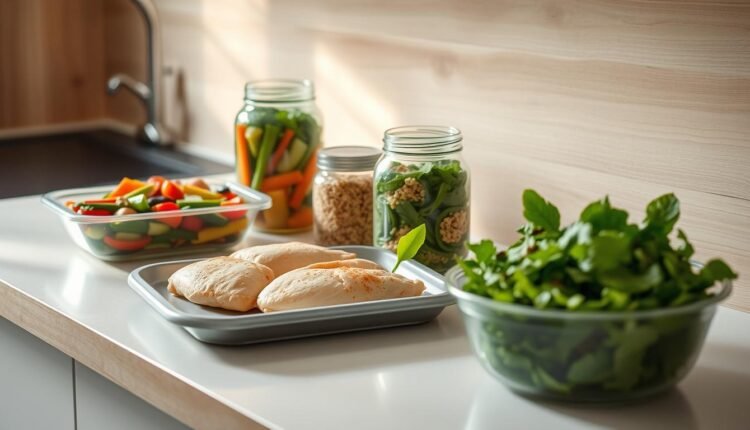Lunch Meal Prep Prep Ahead Components For Assembly
Get started with lunch meal prep prep ahead components for assembly. Practical meal prep strategies for busy lives on Prepistry.com
Between school drop-offs and back-to-back meetings, most of us don’t have time to craft Instagram-worthy midday meals. But here’s the secret: strategic prep-ahead components turn chaotic mornings into smooth, nourishing wins. Think of it like building a pantry toolkit—when you batch-cook versatile bases and flavor heroes, assembly becomes faster than waiting in a drive-thru line.
I’ve spent years refining this approach in my own kitchen (with plenty of burnt quinoa experiments along the way). The magic lies in breaking tasks into three categories: proteins that hold up well, veggie-packed bases, and zesty accents. Store them separately, then mix-and-match all week. Suddenly, that sad desk salad transforms into a vibrant grain bowl with minimal effort.
- Transform hectic mornings with ready-to-assemble components
- Create restaurant-quality meals using batch-prepped ingredients
- Adapt techniques to fit dietary needs and time constraints
Lunch Meal Prep Prep Ahead Components
Juggling work deadlines and family schedules leaves little room for kitchen creativity come noon. But here’s the game-changer: a well-stocked arsenal of mix-and-match elements transforms rushed afternoons into satisfying midday breaks. Imagine opening your fridge to find crisp veggie bases, protein-packed stars, and zesty sauces ready for action.
Think beyond basic salads. Crunchy wraps, grain bowls bursting with color, and even upgraded sandwiches become possible when you separate tasks. “Batch-cooking individual parts gives you endless combinations without repetition,” notes a meal planning expert I collaborate with. This method works whether you’re crafting spicy variations or kid-friendly options.
Three pillars form the foundation:
- Sturdy bases (quinoa, roasted sweet potatoes)
- Flavor anchors (marinated proteins, pickled veggies)
- Finishing touches (herb dressings, toasted seeds)
Store components in clear containers for grab-and-go ease. By Friday, that ginger-miso dressing might top a grain bowl or become a sandwich spread. Flexibility is key—dietary needs change, but your prep system doesn’t have to.
Up next? We’ll explore each element in detail, from choosing freezer-friendly grains to building dressings that stay vibrant all week. No culinary degree required—just practical steps for real-life kitchens.
Essentials of Meal Prep for Lunch
Ever opened your fridge at noon only to find wilted greens and questionable leftovers? The secret to avoiding this lies in treating salads as edible architecture. Start with crisp bases like kale or butter lettuce—they’re the sturdy foundation that keeps everything upright for days. I learned this the hard way after tossing one too many soggy spinach mixes.
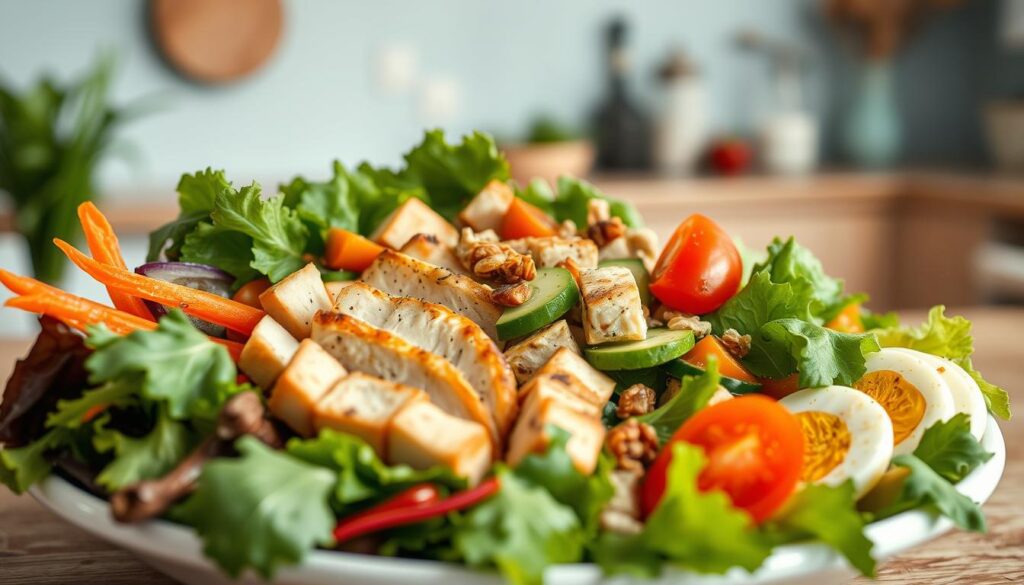
Proteins transform these creations from side dishes to main events. Grilled chicken thighs stay juicy longer than breasts, while chickpeas roasted with smoked paprika add plant-powered crunch. “Think of proteins as your hunger insurance policy,” says nutritionist Dr. Elena Torres. Hard-boiled eggs or marinated tofu work equally well, depending on your dietary needs.
Variety prevents boredom. Rotate between Mediterranean-inspired bowls with feta and olives, or Asian-style mixes featuring sesame-glazed veggies. The key is balancing textures and flavors—creamy avocado against tart apples, or crunchy almonds softening in ginger dressing.
Don’t fear experimentation. Swap romaine for shredded Brussels sprouts one week, or try massaging kale with lemon to reduce bitterness. Store dressings separately in small jars, and you’ll never face a limp lunch again. Your future self will thank you when Thursday’s salad tastes as vibrant as Monday’s.
Planning Your Lunch Meal Prep Ahead Strategy
Picture this: It’s 7:32 AM, and you’re simultaneously packing backpacks while searching for car keys. This is where smart kitchen planning becomes your secret weapon. Through trial and error (and many forgotten containers), I’ve discovered three non-negotiable steps for creating grab-and-go options that work at home.
Identifying Key Components
Start by auditing your kitchen every Saturday. Check expiration dates and note what needs using first. One blogger I follow keeps a “use me” shelf for ingredients nearing their prime—a genius hack I’ve adopted. Focus on versatile items like cooked grains or roasted veggies that pair with multiple proteins.
Timing and Scheduling Tips
Block 90 minutes on Sundays for your prep session. Here’s my rhythm:
- 10 minutes: Wash/chop crunchier veggies (bell peppers last better than cucumbers)
- 25 minutes: Roast proteins and sturdy vegetables
- 15 minutes: Portion dressings and snacks
Store components in labeled containers at eye level. “Visibility reduces decision fatigue during hectic mornings,” notes meal prep coach Jamie Lin. This system helps me use every ingredient before Friday—no more science experiments in the back of the fridge.
Remember, flexibility trumps perfection. Forgot to cook quinoa? Use whole-grain tortillas from the freezer instead. Your future self will appreciate having options ready when the day gets chaotic.
Ingredients That Make a Difference
The difference between a forgettable dish and a standout one often lies in the components you choose. I’ve learned through trial (and many bland experiments) that thoughtful ingredient selection builds meals worth savoring—not just enduring.
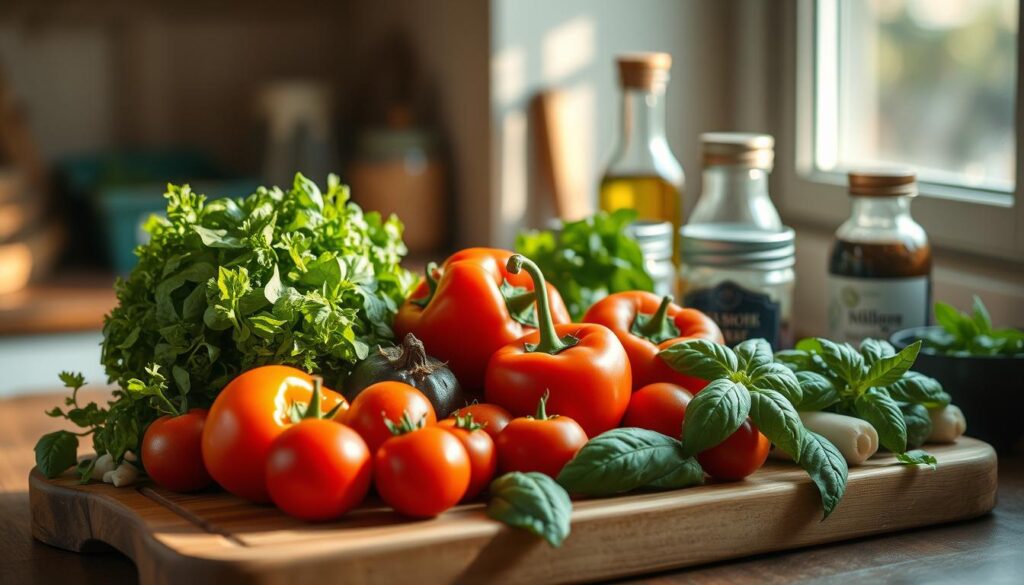
Proteins, Grains, and Veggies
High-quality proteins anchor your creations. Chicken thighs roasted with olive oil stay juicy for days, while marinated tempeh offers plant-powered versatility. Pair these with grains like farro or wild rice—they absorb dressings beautifully without turning mushy.
Crunchy veggies add texture and nutrients. Try spiralized zucchini for grain-free bowls or roasted Brussels sprouts for earthy depth. “The right vegetable combinations turn basic meals into flavor adventures,” says chef Marcus Ware in his latest cookbook. My go-to move? Toss broccoli florets with garlic powder before roasting—they become crispy, craveable nuggets.
Fresh Produce and Flavor Boosters
Vibrant produce elevates every bite. Persian cucumbers stay crisp longer than standard varieties, while rainbow chard adds color to stir-fries. Don’t underestimate simple upgrades:
- Swap iceberg lettuce for butter lettuce—it’s sturdier and more nutrient-dense
- Use fresh herbs like dill or basil as edible confetti
- Add pickled red onions for tangy brightness
These elements transform routine meals into nourishing experiences. When you combine quality ingredients with smart prep, even Tuesday’s desk meal feels intentional.
Building a Balanced Lunch: Salads, Bowls, and More
What transforms a basic midday dish into something crave-worthy? The answer lies in strategic layering and color contrast. Let me show you how I build vibrant creations that fuel busy days—without requiring chef-level skills.
Creative Salad and Bowl Ideas
Start with quinoa as your foundation. This protein-packed grain holds dressings beautifully and stays fluffy for days. I learned this after burning my first batch—now I cook it in vegetable broth for extra flavor. Top it with roasted sweet potatoes or massaged kale for contrasting textures.
Visual appeal matters as much as taste. Arrange ingredients in sections rather than tossing everything together. A nutritionist friend once told me, “We eat with our eyes first.” Try this formula:
| Base | Protein | Toppings |
|---|---|---|
| Quinoa + spinach | Lemon-herb chicken | Cherry tomatoes, avocado, sunflower seeds |
| Mixed greens | Spiced chickpeas | Shredded carrots, pickled onions, tahini drizzle |
| Brown rice | Teriyaki tofu | Edamame, cucumber ribbons, sesame seeds |
Don’t shy away from bold combinations. Last week, I paired grilled peaches with arugula and goat cheese—it became an instant favorite. Store components separately, then assemble each morning for maximum crunch. Your coworkers might start asking for your “restaurant recipe” secrets!
Flavor Enhancements: Dressings and Sauces for Lunch
That moment when your fork hits a perfectly dressed bite? That’s kitchen magic in action. Dressings and sauces aren’t just toppings—they’re flavor translators that turn humble ingredients into memorable meals. I once salvaged a bland veggie mix with a five-minute peanut sauce, proving even simple components shine with the right accent.
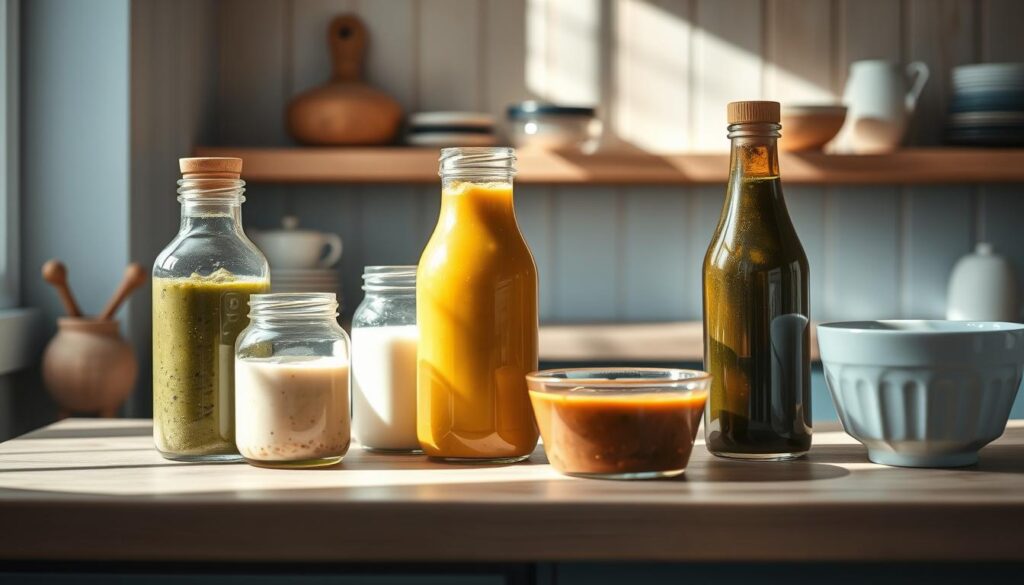
Start with a basic vinaigrette formula: 3 parts oil to 1 part acid (like lemon or vinegar), plus flavor boosters. My current obsession? Whisking miso paste into rice vinegar for umami depth. For creamy options, blend Greek yogurt with roasted garlic or swirl peanut butter into coconut milk for a Thai-inspired drizzle.
Pairing matters. Bright citrus dressings lift grilled fish, while tahini-based sauces complement roasted veggies. A chef friend once told me, “Sauces should echo your ingredients, not overpower them.” Try these combos:
- Honey-mustard with apple-kale salads
- Peanut-lime sauce for grain bowls
- Green goddess dressing over chicken wraps
Store creations in small jars—shake before using to emulsify. Oily bases keep 5 days; dairy-based versions last 3. Pro tip: Freeze herb-packed pesto in ice cube trays for instant flavor bursts.
One tablespoon of sauce can transform Thursday’s leftovers into Friday’s favorite dish. Keep experimenting until you find your signature drizzle—it’s the easiest way to make every bite feel intentional.
Exploring Protein Options: Chicken, Egg, and Beyond
Let’s talk about the unsung heroes of your midday fuel—proteins that keep you satisfied without demanding last-minute effort. Whether you’re team plant-based or crave classic flavors, smart protein prep turns scattered ingredients into cohesive meals.
Choosing the Right Protein for Meal Prep
Eggs are my weekday MVPs. Hard-boiled versions travel well, while muffin tin frittatas let spinach and peppers shine. For chicken salad lovers, poaching breasts in broth prevents dryness—a trick I learned after serving hockey puck-textured sandwiches to unimpressed friends.
Avocado steps in as nature’s mayo alternative. Mash it into shredded chicken with lime zest for a creamy twist. “Pairing lean proteins with healthy fats balances energy levels,” explains dietitian Clara Myers. Try these combos:
- Smoked salmon + avocado slices on rye crackers
- Curried egg salad with Greek yogurt base
- Shredded BBQ chicken with jicama slaw
Texture preservation matters. Roast chickpeas at 425°F for crunch that survives refrigeration. Marinate tofu in sesame-ginger sauce overnight—it absorbs flavors better than rushed 30-minute soaks. My golden rule? Cool proteins completely before storing to prevent steam-induced sogginess.
| Protein | Prep Method | Pairing Tip |
|---|---|---|
| Eggs | Hard-boil + peel | Add to grain bowls or wraps |
| Chicken | Shred + sauce | Mix with crunchy veggies |
| Chickpeas | Roast + season | Toss into salads |
Don’t limit yourself—lentil patties or marinated tempeh make exciting swaps. Last week’s buffalo chickpea wraps disappeared faster than my kids’ snack stash. What will you try first?
Incorporating Quinoa and Other Grains for Nutritional Boost
Ever stared into your pantry wondering how to turn basic ingredients into satisfying creations? Whole grains like quinoa and rice become your secret weapons—they’re nutrient-rich canvases waiting for colorful toppings. My Mediterranean quinoa salad recipe (more on that later) proves these humble ingredients can steal the show.
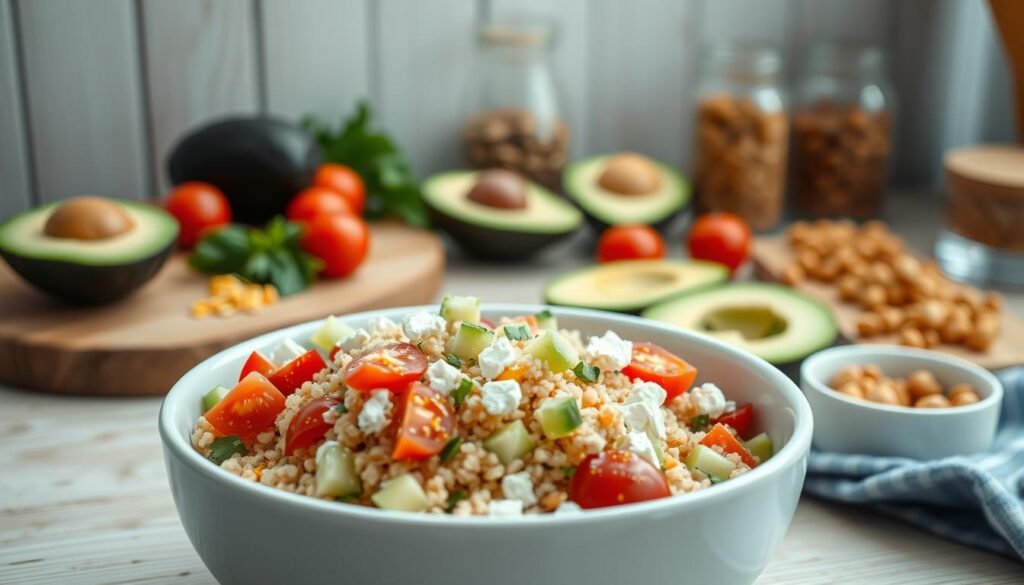
Quinoa’s complete protein profile makes it ideal for plant-based bowls. One cup delivers all nine essential amino acids plus magnesium for energy support. Here’s my go-to trick: Cook it in broth with garlic cloves for savory depth. Fluff with a fork after steaming to prevent mushiness—a lesson learned from my first gummy batch.
Pair grains with vibrant add-ons:
- Mix jasmine rice with roasted veggies and peanut sauce
- Fold wild rice into kale salads with dried cranberries
- Top farro with grilled chicken and lemon-tahini drizzle
Storing cooked grains? Spread them on baking sheets to cool completely before refrigerating. This stops condensation from creating a soggy mess. Nutritionist Dr. Lisa Chen advises, “Grains retain texture best when stored separately from dressings.”
| Grain | Cooking Time | Flavor Pairings |
|---|---|---|
| Quinoa | 15 mins | Feta, olives, lemon |
| Brown rice | 40 mins | Teriyaki, edamame, sesame |
| Freekeh | 25 mins | Roasted squash, pepitas |
Rotate grains weekly to avoid boredom. Swap quinoa for bulgur in tabbouleh, or use black rice for dramatic sushi bowls. Your gut microbiome thrives on diversity—and your taste buds will too.
Meal Prep Techniques for Busy Lifestyles
Let’s face it—your Wednesday afternoon self will thank your Sunday morning self when components come together smoothly. Through years of balancing restaurant shifts and family dinners, I’ve honed strategies that turn chaotic weeks into manageable rhythms. The key? Treat your kitchen like a well-oiled assembly line.
Time-Saving Prep and Assembly Tips
Start with a 15-minute ingredient triage. Chop onions, roast veggies, and marinate proteins simultaneously. Use this formula:
| Minutes | Task | Payoff |
|---|---|---|
| 5 | Chop base veggies | 3 days of salad starters |
| 7 | Batch-cook grains | 4 versatile meal foundations |
| 3 | Portion dressings | Flavor control all week |
Store components in clear glass containers—you’ll spot what you need fast. “Stackable systems reduce decision fatigue,” says meal prep guru Sarah Klein. Freeze sauces in silicone molds for instant upgrades later.
Storing and Reheating Strategies
Keep textures crisp with smart storage. Place paper towels under greens to absorb moisture. For wraps, layer fillings between lettuce leaves to prevent soggy tortillas.
“Reheat proteins separately from grains using 50% power—it preserves moisture better than blasting full heat.”
Try these methods:
- Microwave rice with a damp paper towel
- Revive roasted veggies in air fryers
- Thaw frozen soups overnight in fridge
Consistency beats perfection. Even 30 minutes of prep creates building blocks for stress-free days. Your future self deserves that victory.
Creative Wraps, Sandwiches, and Bowl Assemblies
What if your morning routine included building flavorful handheld meals in under three minutes? With prepped components, you can transform basic ingredients into vibrant wraps and sandwiches that defy desk-drawer boredom. I discovered this after a disastrous attempt at pre-assembled burritos—lesson learned: separate storage is key.
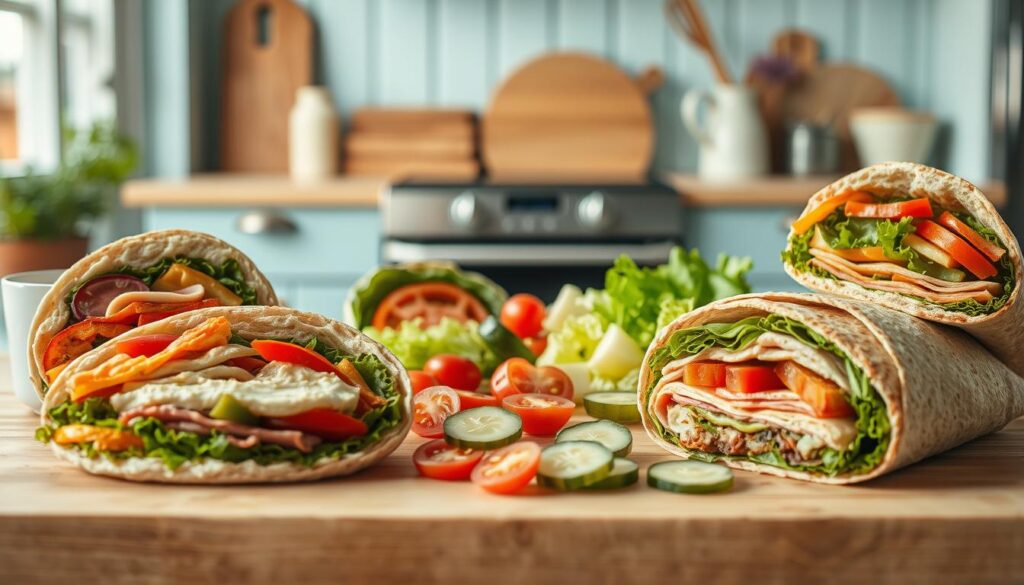
Start with versatile foundations. Roasted turkey pairs equally well with cranberry sauce for Thanksgiving vibes or sriracha mayo for spicy crunch. “Separating components maintains texture integrity,” says meal prep coach Tara Simmons. Try these combos:
| Flavor Profile | Protein | Crunch Factor |
|---|---|---|
| Mediterranean | Lemon-chicken | Pickled onions + cucumbers |
| Asian-inspired | Sesame tofu | Wonton strips + snap peas |
| Tex-Mex | BBQ jackfruit | Tortilla strips + jicama |
Store hummus and veggies separately. Assemble wraps each morning. Your future self will thank you when Thursday’s creation stays crisp.
“Moisture management turns good sandwiches into great ones—keep dressings in tiny containers until serving.”
Bowl assemblies offer endless customization. Layer cooked grains, proteins, and quick-pickled veggies in divided containers. Top with nuts or herbs before eating. Your kitchen becomes a mix-and-match studio where every combination feels fresh.
The Importance of Practical and Hearty Components
Ever faced a Thursday container that looks sadder than Monday’s enthusiasm? The secret to week-long satisfaction lies in choosing ingredients that age like fine wine—sturdy, flavorful, and ready for action. As Budget Bytes founder Beth Moncel notes, “Hearty components turn meal prep from a chore into a reliable kitchen ally.”
Long-lasting Ingredients for Week-Long Freshness
Robust soups shine here. Lentil stew or minestrone develop deeper flavors by day three, unlike delicate greens that wilt overnight. For dinner-inspired dishes, try roasted root vegetables paired with braised meats—they reheat beautifully without turning mushy.
Smart storage preserves textures. Keep crispy elements like croutons or nuts in separate containers. This approach reduces food waste while keeping midday dishes exciting. Try these winners:
- Chili with kidney beans and sweet potatoes
- Curried cauliflower and chickpea bowls
- Shredded chicken with wild rice pilaf
Practical choices create consistency. “Sturdy ingredients forgive imperfect storage conditions,” says Downshiftology’s Lisa Bryan. Choose vegetables like cabbage over spinach, and grains like farro instead of delicate couscous. Your future self will relish every bite—even on hectic days.
How to Master lunch meal prep prep ahead for Consistent Quality
Ever opened a Thursday container expecting blandness but found vibrant tastes instead? That’s the power of intentional flavor-building. My “roasted veggie redemption” moment came after serving mushy zucchini—now I swear by high-heat roasting for caramelized edges that survive refrigeration.

Texture preservation starts with smart cooking methods. Roast cauliflower at 425°F for crispy florets that hold up for days. Marinate proteins in acidic bases like lemon juice or vinegar—they tenderize while locking in moisture. As meal prep blogger Jenna Weber notes:
“A 24-hour marinade transforms basic chicken into a flavor magnet that pairs with any grain or green.”
Balance bold and subtle elements. Drizzle honey over spicy roasted carrots to create sweet-heat harmony. Try this formula for balanced seasoning:
| Component | Flavor Booster | Storage Tip |
|---|---|---|
| Proteins | Garlic-herb rub | Cool completely before storing |
| Veggies | Balsamic glaze | Roast until slightly underdone |
| Grains | Toasted spices | Mix with oil to prevent clumping |
Trust your taste buds. My failed attempt at turmeric-heavy rice taught me to add spices gradually. Now I keep small jars of pre-mixed seasonings—adjust as needed throughout the week.
Consistency comes through practice, not perfection. Start with one roasted element per meal, then expand your repertoire. Those slightly charred Brussels sprouts might just become your new Thursday hero.
Adapting Your Meal Prep for Different Dietary Requirements
Your best friend’s gluten-free, your sister’s vegan, and your neighbor avoids soy—how do you cook for everyone without losing your mind? The answer lies in building flexible components that adapt to restrictions without sacrificing satisfaction. Let’s explore swaps that keep flavors bold and textures exciting.
Plant-Powered Reinventions
Legume-based pasta transforms classic dishes into protein-packed vegan wins. Chickpea noodles hold up beautifully in marinara, while black bean spaghetti pairs perfectly with roasted veggies. For heartiness, try lentil chili or white bean salads—they’re filling enough to please meat-lovers too.
Allergy-Smart Solutions
Rice noodles become heroes in gluten-free stir-fries. Pair them with tamari instead of soy sauce for nutty depth. “Cross-contamination is the silent saboteur,” warns nutritionist Priya Shah. Use dedicated cutting boards and store allergy-friendly components in brightly colored containers.
| Traditional | Swap | Benefit |
|---|---|---|
| Wheat pasta | Edamame noodles | Higher protein + gluten-free |
| Croutons | Toasted chickpeas | Crunch without gluten |
| Soy sauce | Coconut aminos | Lower sodium + soy-free |
Flavor stays king. Roast smoked paprika-spiced beans for taco bowls, or toss zucchini noodles with peanut sauce. My kitchen fail? Using undercooked lentil pasta—now I boil it 2 minutes less than package directions. Texture matters as much as taste.
Experiment fearlessly. Swap rice paper wraps for collard greens in spring rolls, or use puréed beans as a creamy soup base. Dietary needs shouldn’t limit creativity—they’re invitations to discover new favorites.
Innovative Recipes and Meal Ideas Inspired by Top Sources
What if your midday break could rival your favorite café’s specials board? Trending recipes prove pantry staples transform into craveable creations with clever twists. Take smashed chickpea salads—mash those legumes with lemon zest and olive oil, then pile onto crusty bread with roasted peppers and feta crumbles. Suddenly, desk dining feels decadent.
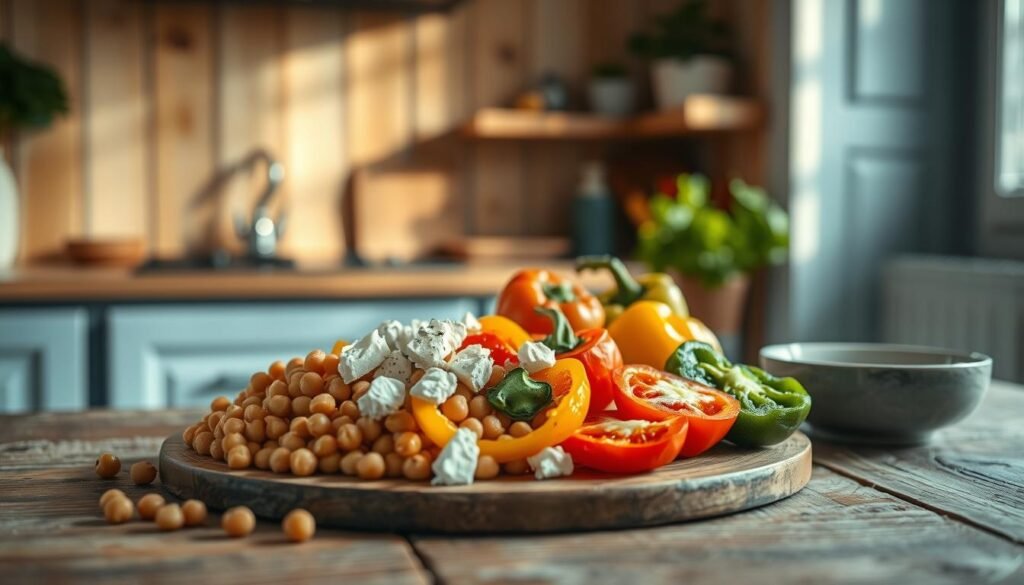
Modern Mediterranean-inspired dishes showcase how simple swaps create excitement. Try these combos:
| Base | Star Ingredient | Flavor Boost |
|---|---|---|
| Quinoa | Marinated chickpeas | Feta + preserved lemon |
| Mixed greens | Chargrilled peppers | Toasted pine nuts + mint |
| Pita pockets | Spiced chickpea spread | Pickled onions + dill |
Food blogger Gina Homolka shares: “Prepping components separately lets you build restaurant-quality plates in minutes.” Roast peppers on Sunday—use them in grain bowls, wraps, or as pizza toppings. Crumble feta over roasted veggies or blend into dressings for creamy tang.
Stay inspired by seasonal produce. Summer’s ripe tomatoes pair beautifully with chickpea couscous, while winter squash shines in feta-studded salads. Your components become building blocks for endless creativity. Who knew a humble legume could feel so gourmet?
Overcoming Common Meal Prep Challenges
We’ve all experienced that disappointing crunch—or lack thereof—when opening a container of once-crispy veggies. Texture betrayal is real, but entirely preventable with smart strategies. Let’s tackle the sneaky culprits behind soggy creations and flavor fade.
Preserving Texture and Taste
My “great wrap disaster of 2022” taught me valuable lessons. Storing all components together turned my chicken Caesar wrap into a sad, damp mess. Now I swear by these moisture-management tactics:
- Line salad containers with paper towels to absorb excess liquid
- Store dressings in reusable squeeze bottles for last-minute drizzling
- Keep crumbled feta or sharp cheddar in separate compartments
Bean salads particularly benefit from acidic marinades. Toss black bean mixtures with lime juice—it strengthens their structure while enhancing flavor. For grain-based dishes, let them cool completely before refrigerating to prevent steam buildup.
“Treat your containers like a toolbox—each ingredient needs its own protective space until assembly.”
| Component | Storage Solution | Freshness Window |
|---|---|---|
| Leafy Greens | Paper towel + airtight container | 5 days |
| Cheese | Parchment-lined glass jar | 7 days |
| Roasted Veggies | Vented container | 4 days |
Morning assembly becomes your secret weapon. Layer ingredients strategically—denser items at the bottom, delicate greens on top. Need to reheat components? Our friends at Prepistry share smart reheating strategies that preserve textures.
Remember: A little separation goes a long way. That crisp snap of fresh peppers or the satisfying crumble of goat cheese? Worth the extra minute spent organizing your cheese section. Your taste buds—and desk mates—will notice the difference.
Your kitchen becomes a creativity lab when you view meal assembly as building blocks rather than daily chores. Through years of burnt grains and over-marinated proteins, I’ve learned success lies in three non-negotiables: intentional planning, quality ingredients, and flexible execution.
A reliable system transforms ordinary routines. Batch-roasted veggies become grain bowl foundations. Marinated proteins shift from salads to wraps. Those vibrant dressings? They’re flavor bridges connecting different dishes throughout the week.
Remember—perfection isn’t the goal. My Thursday desk meals often look different than Monday’s creations, and that’s okay. Start small: master one base recipe, then experiment with seasonal swaps. Did roasted squash work better than sweet potatoes? File that win for next month.
True kitchen freedom comes through adaptation. Use these strategies as launchpads, not rigid rules. Your unique needs and tastes should guide every component choice. That’s the real recipe for lasting success—one nourishing, satisfying creation at a time.
Lemony Chickpea Orzo Lunch Bowls
A refreshing and protein-packed vegetarian lunch bowl featuring tender orzo pasta, hearty chickpeas, and crisp vegetables, all tossed in a zesty lemon-dill dressing. Perfect for meal prep or a light, satisfying meal.
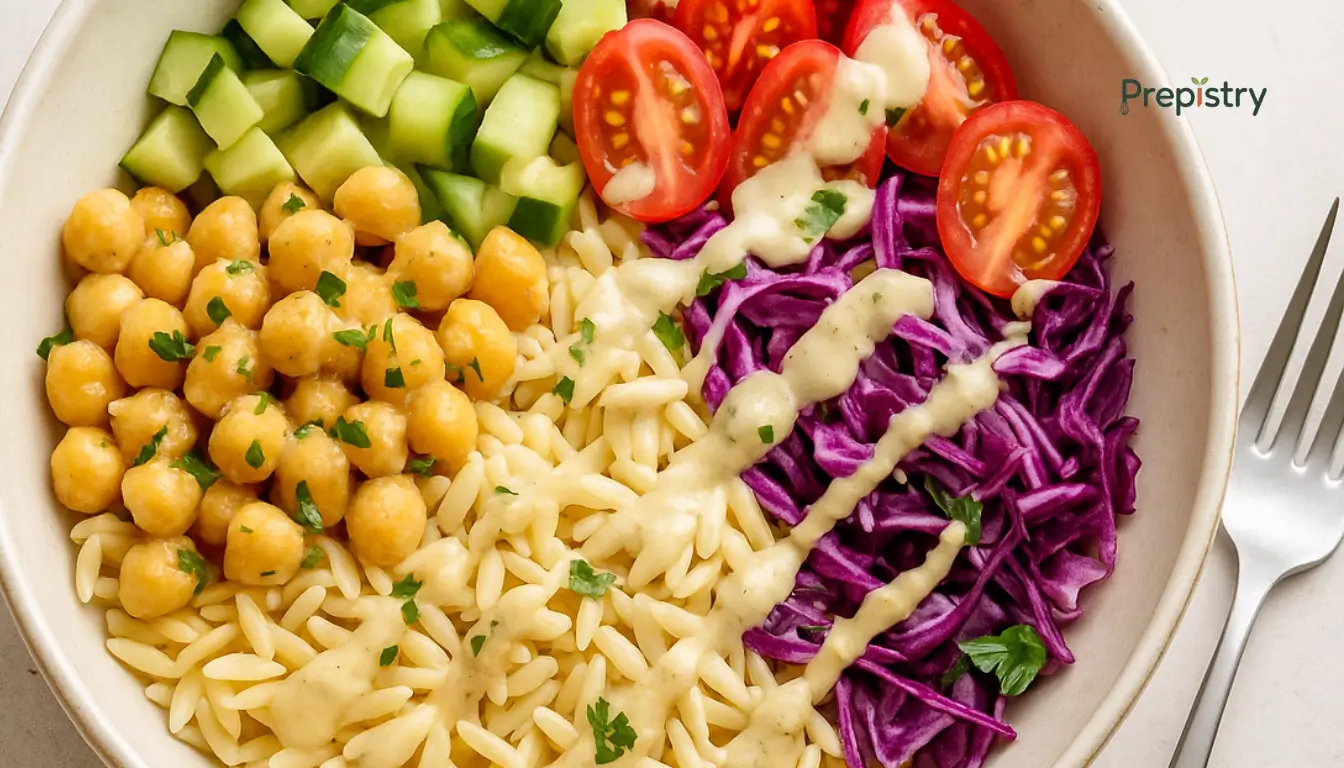
Nutrition Information
Equipment Needed
- Large pot
- Colander
- Mixing bowl
- Whisk
- Knife
- Cutting board
Ingredients
-
1 cup orzo pasta
-
1 can (15 oz) chickpeas, drained and rinsed
-
1 cup cucumber, diced
-
1 cup cherry tomatoes, halved
-
1/4 cup red onion, finely chopped
-
1/4 cup fresh dill, chopped
-
2 tablespoons olive oil
-
2 tablespoons fresh lemon juice
-
1 teaspoon lemon zest
-
1 teaspoon Dijon mustard
-
Salt and pepper to taste
Instructions
Recipe Video
Lemony Chickpea Orzo Lunch Bowls Recipe
Learn how to make refreshing and protein-packed Lemony Chickpea Orzo Lunch Bowls, perfect for meal prep or a light, satisfying meal.

